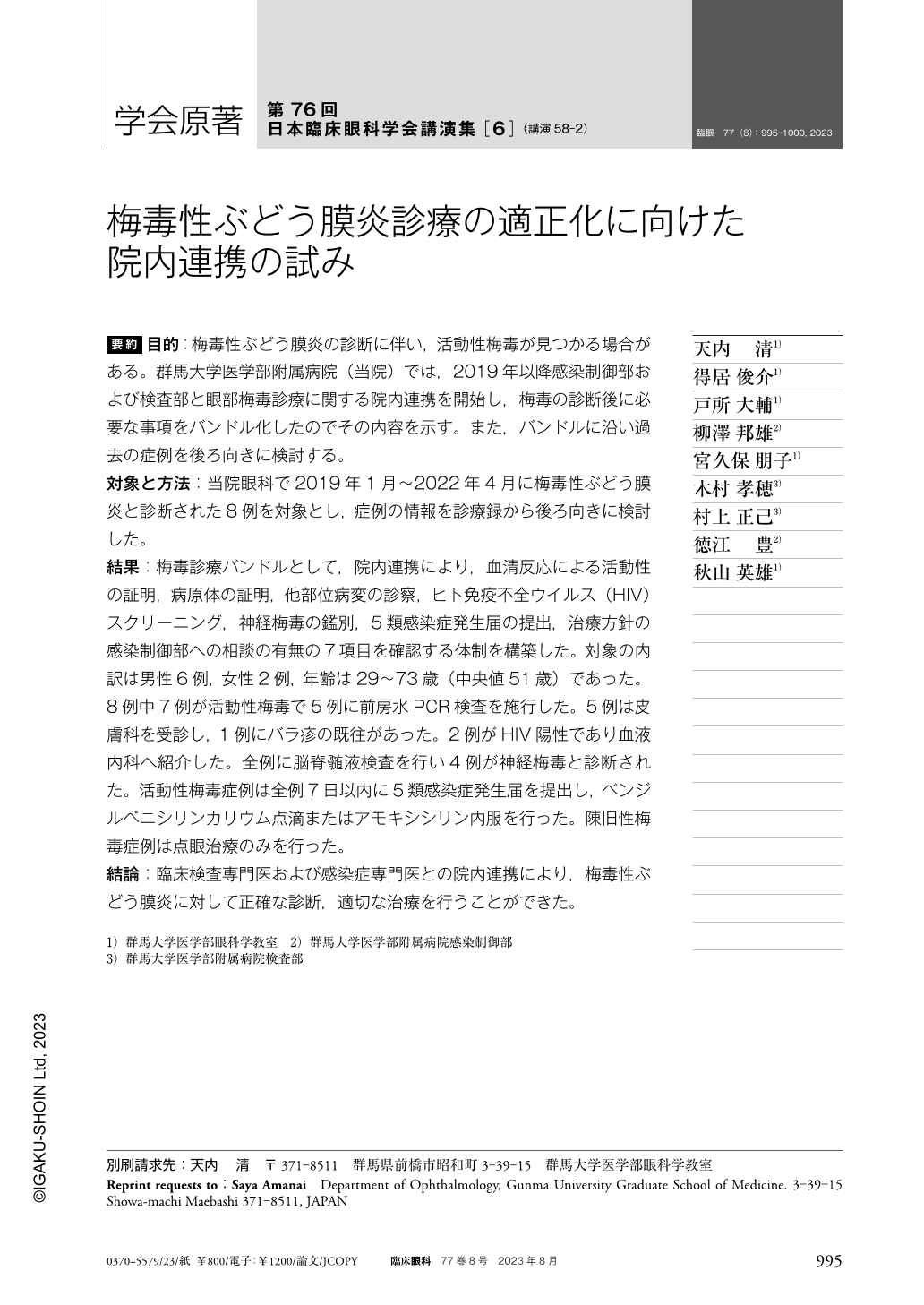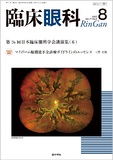Japanese
English
- 有料閲覧
- Abstract 文献概要
- 1ページ目 Look Inside
- 参考文献 Reference
要約 目的:梅毒性ぶどう膜炎の診断に伴い,活動性梅毒が見つかる場合がある。群馬大学医学部附属病院(当院)では,2019年以降感染制御部および検査部と眼部梅毒診療に関する院内連携を開始し,梅毒の診断後に必要な事項をバンドル化したのでその内容を示す。また,バンドルに沿い過去の症例を後ろ向きに検討する。
対象と方法:当院眼科で2019年1月〜2022年4月に梅毒性ぶどう膜炎と診断された8例を対象とし,症例の情報を診療録から後ろ向きに検討した。
結果:梅毒診療バンドルとして,院内連携により,血清反応による活動性の証明,病原体の証明,他部位病変の診察,ヒト免疫不全ウイルス(HIV)スクリーニング,神経梅毒の鑑別,5類感染症発生届の提出,治療方針の感染制御部への相談の有無の7項目を確認する体制を構築した。対象の内訳は男性6例,女性2例,年齢は29〜73歳(中央値51歳)であった。8例中7例が活動性梅毒で5例に前房水PCR検査を施行した。5例は皮膚科を受診し,1例にバラ疹の既往があった。2例がHIV陽性であり血液内科へ紹介した。全例に脳脊髄液検査を行い4例が神経梅毒と診断された。活動性梅毒症例は全例7日以内に5類感染症発生届を提出し,ベンジルペニシリンカリウム点滴またはアモキシシリン内服を行った。陳旧性梅毒症例は点眼治療のみを行った。
結論:臨床検査専門医および感染症専門医との院内連携により,梅毒性ぶどう膜炎に対して正確な診断,適切な治療を行うことができた。
Abstract Purpose:Active syphilis may be detected after the diagnosis of syphilitic uveitis. In our hospital, we have started referring patients with ocular syphilis to the institutional Infection Control and Prevention Center and Department of Clinical Laboratory since 2019, and have developed an information bundle on the steps to be taken after the diagnosis of syphilis, the contents of which are presented here. In addition, we have retrospectively reviewed our approaches described in the bundle.
Methods:Eight patients diagnosed with syphilitic uveitis between January 2019 and April 2022 at the Department of Ophthalmology, Gunma University Hospital, were included in this study. We retrospectively reviewed their clinical information using medical records.
Results:Through the syphilis treatment bundle, we established a system to confirm the following seven points through intra-hospital referrals:proof of activity by serological reaction, proof of pathogens, screening of lesions other than ocular lesions, HIV screening, detection of neurosyphilis, submission of a report to the Public Health Center for this Category 5 infectious disease, and consultation with experts about treatment strategy. We studied the cases of six men and two women(median age, 51 years;range, 29-73 years). Seven of the eight patients had active syphilis, and five of them underwent a polymerase chain reaction test using aqueous humor. Five patients consulted dermatologists, and one had a history of cutaneous lesions. Two patients were confirmed to be HIV-positive and were referred to the Hematology Department. All patients were examined for lumbar puncture, and four were diagnosed as neurosyphilis. All patients with active syphilis were notified of the diagnosis within 7 days and were treated with benzylpenicillin potassium infusion or oral amoxicillin. Latent syphilis was treated only with eyedrops.
Conclusion:With the cooperation of laboratory specialists and infectious disease specialists, we could accurately diagnose and appropriately treat syphilitic uveitis.

Copyright © 2023, Igaku-Shoin Ltd. All rights reserved.


